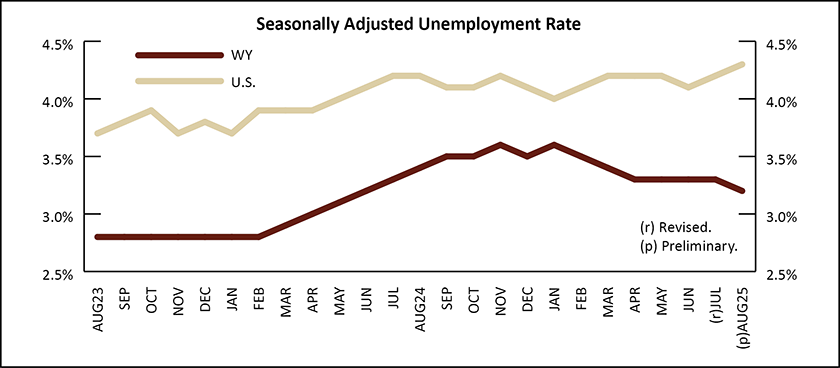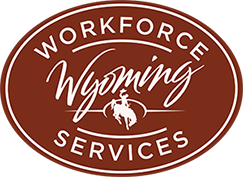Wyoming Labor Force Trends
October 2025 | Volume 62, No. 10
Click Here for PDF
Return to Table of Contents
Wyoming Unemployment Falls to 3.2% in August 2025
by: David Bullard, Senior Economist
The Research & Planning section of the Wyoming Department of Workforce Services reported that the state’s seasonally adjusted1 unemployment rate fell from 3.3% in July to 3.2% in August. Wyoming’s unemployment rate is slightly lower than its August 2024 level of 3.4% and much lower than the current U.S. rate of 4.3%.
From July to August, most county unemployment rates changed very little. Unemployment rates fell in Sweetwater (down from 3.5% to 3.1%), Fremont (down from 3.5% to 3.1%), and Campbell (down from 2.9% to 2.5%) counties, while unemployment rates rose in Platte (up from 3.3% to 3.7%) and Goshen (up from 2.9% to 3.2%) counties.
From August 2024 to August 2025, unemployment rates fell in 20 counties, rose in two counties, and remained unchanged in Uinta County (3.1%). The largest decreases occurred in Johnson (down from 2.9% to 2.1%), Weston (down from 3.0% to 2.4%), and Lincoln (down from 2.7% to 2.1%) counties. The two areas where unemployment rates increased were Hot Springs County (up from 2.8% to 3.0%) and Niobrara County (up from 3.2% to 3.4%).
In August, the highest unemployment rates were found in Platte County at 3.7%, Big Horn County at 3.5%, and Niobrara County at 3.4%. The lowest rates were reported in Teton County at 1.5%, Lincoln County at 2.1%, and Johnson County at 2.1%.
Current Employment Statistics (CES) estimates show that total nonfarm employment in Wyoming (not seasonally adjusted and measured by place of work) rose from 300,900 in August 2024 to 302,100 in August 2025, an increase of 1,200 jobs (0.4%).
R&P's most recent monthly news release is available at https://doe.state.wy.us/LMI/news.htm.



 Hire Wyo
Hire Wyo